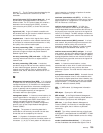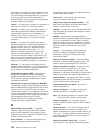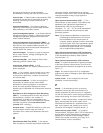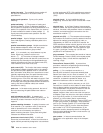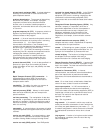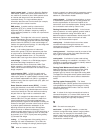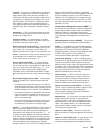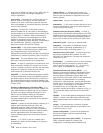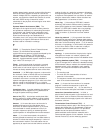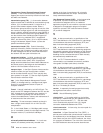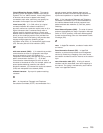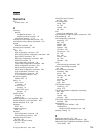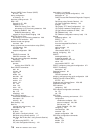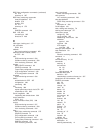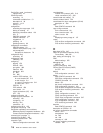problem determination requests, and providing directory
services and other session services for users of the
network. Multiple SSCPs, cooperating as peers with one
another, can divide the network into domains of control,
with each SSCP having a hierarchical control
relationship to the physical units and logical units within
its own domain.
Systems Network Architecture (SNA). The
description of the logical structure, formats, protocols,
and operational sequences for transmitting information
units through, and controlling the configuration and
operation of, networks. The layered structure of SNA
allows the ultimate origins and destinations of
information, that is, the users, to be independent of and
unaffected by the specific SNA network services and
facilities used for information exchange.
T
TCP/IP. (1) Transmission Control Protocol/Internet
Protocol. (2) A UNIX-like/Ethernet-based
system-interconnect protocol originally developed by the
US Department of Defense. TCP/IP facilitated
ARPANET (Advanced Research Projects Agency
Network), a packet-switched research network for which
layer 4 was TCP and layer 3, IP.
Telnet. In the Internet suite of protocols, a protocol
that provides remote terminal connection service. It
allows users of one host to log on to a remote host and
interact as directly attached terminal users of that host.
threshold. (1) In IBM bridge programs, a value set for
the maximum number of frames that are not forwarded
across a bridge due to errors, before a “threshold
exceeded” occurrence is counted and indicated to
network management programs. (2) An initial value from
which a counter is decremented to 0, or a value to
which a counter is incremented or decremented from an
initial value.
throughput class. In packet switching, the speed at
which data terminal equipment (DTE) packets travel
through the packet switching network.
time to live (TTL). A technique used by best-effort
delivery protocols to inhibit endlessly looping packets.
The packet is discarded if the TTL counter reaches 0.
timeout. (1) An event that occurs at the end of a
predetermined period of time that began at the
occurrence of another specified event. (I) (2) A time
interval allotted for certain operations to occur; for
example, response to polling or addressing before
system operation is interrupted and must be restarted.
token. (1) In a local area network, the symbol of
authority passed successively from one data station to
another to indicate the station temporarily in control of
the transmission medium. Each data station has an
opportunity to acquire and use the token to control the
medium. A token is a particular message or bit pattern
that signifies permission to transmit. (T) (2) In LANs,
a sequence of bits passed from one device to another
along the transmission medium. When the token has
data appended to it, it becomes a frame.
token ring. (1) According to IEEE 802.5, network
technology that controls media access by passing a
token (special packet or frame) between media-attached
stations. (2) IEEE 802.5 network with a ring topology
that passes tokens from one attaching ring station
(node) to another. (3) See also
local area network
(LAN)
.
token-ring network. (1) A ring network that allows
unidirectional data transmission between data stations,
by a token passing procedure, such that the transmitted
data return to the transmitting station. (T) (2) A network
that uses a ring topology, in which tokens are passed in
a circuit from node to node. A node that is ready to
send can capture the token and insert data for
transmission.
topology. In communications, the physical or logical
arrangement of nodes in a network, especially the
relationships among nodes and the links between them.
topology database update (TDU). A message about
a new or changed link or node that is broadcast among
APPN network nodes to maintain the network topology
database, which is fully replicated in each network
node. A TDU contains information that identifies the
following:
v The sending node
v The node and link characteristics of various
resources in the network
v The sequence number of the most recent update for
each of the resources described.
trace. (1) A record of the execution of a computer
program. It exhibits the sequences in which the
instructions were executed. (A) (2) For data links, a
record of the frames and bytes transmitted or received.
transceiver (transmitter-receiver). In LANs, a
physical device that connects a host interface to a local
area network, such as Ethernet. Ethernet transceivers
contain electronics that apply signals to the cable and
that sense collisions.
Transmission Control Protocol (TCP). A
communications protocol used in the Internet and in any
network that follows the U.S. Department of Defense
standards for internetwork protocol. TCP provides a
reliable host-to-host protocol between hosts in
packet-switched communications networks and in
interconnected systems of such networks. It uses the
Internet Protocol (IP) as the underlying protocol.
Glossary 711



